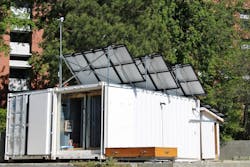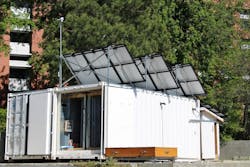Old-Fashioned Cooling Methods Inspire Modern Passive Cooling System
Passive cooling refers to technologies or design features that lower the temperature in spaces without the need for power consumption.
The strategy uses free, renewable sources of energy (wind and sun) to feed cooling and ventilation, so that the need to use a mechanical cooling system can be reduced or even eliminated.
With energy demand for active mechanical space cooling projected to double by 2050, researchers are investigating alternative means, such as passive cooling systems, to help reduce demand.
At Washington State University, for example, researchers have designed a 60-sq.-ft. chamber to test passive systems. Their prototype uses the combined effects of wind towers and water evaporation instead of electricity to cool spaces.
READ MORE: Toward Carbon Neutrality: igus Plugs Heat Recovery Invention at Hannover Messe
“Cooling is increasingly in demand in buildings, especially as the climate gets hotter,” said Al-Hassawi, assistant professor in WSU’s School of Design and Construction. “There might be inclusion of mechanical systems, but how can we cool buildings to begin with—before relying on the mechanical systems?”
Al-Hassawi, the lead author of the study published in the journal Energies, described how his team repurposed a shipping container into a solar-powered chamber. Electrical needs were supplied by photovoltaic panels and a battery bank; a mini-split heat pump provided primary heating, cooling and dehumidification control; and geofoam panels were used as interior insulation to moderate heat exchange with the outer environment and boost the efficiency of chamber environmental controls.
In addition, the geofoam panels were clad with 22-gauge galvanized sheet metal, which minimized friction and turbulence, the researchers noted.
Completely independent of grid power, the chamber can be heated to a temperature range between 125 and 130°F year-round to test cooling innovations, measuring the temperature, humidity and air velocity within and around a cooling system.
READ MORE: Keeping Enclosures Cool
The researchers calibrated the chamber using the results of a full-scale experiment conducted on a passive, downdraft cooling system tested under the hot dry conditions of Phoenix, Ariz.
Heat transfer through direct evaporation of water dates back to ancient Egypt as one of the oldest means of passive cooling, pointed out the authors. More recently, innovations in wind tower design highlighted how a rigid media direct evaporative cooling system could be placed at the top of the tower, causing heavier, cooler air to drop downwards by gravity. This design, developed in the 1980s, was named the passive downdraft evaporative cooling tower (PDECT).
Passive Cooling System Simulator
Al-Hassawi’s passive cooling system experiment creates a unique setting for simulating extreme conditions. “With smaller scale models, we can also do much quicker tests and get results sooner than having to wait on large-scale prototype construction,” he said.
The paper noted that buildings consume about 60% of the world’s electricity, with nearly 20% of that going to keep them cool. In the U.S., nearly 90% of residential homes and apartments use mechanical air conditioners. The concern with powering air conditioning units, said the authors, is that they rely on electricity that’s often generated by fossil fuels, increasing carbon emissions.
Passive cooling systems are occasionally used in hot places like Phoenix, but Al-Hassawi argued that familiarity with passive cooling techniques is for the most part misunderstand.
A passive cooling strategy could be applicable both for existing or new construction, he said: “It’s an older technology, but there’s been an attempt to innovate and use a mix of new and existing technologies to improve performance and the cooling capacity of these systems.”
The authors noted that research for testing passive cooling systems takes considerable investment and training. The test chamber offers a platform for experimentation and innovation, and Al-Hassawi is hopeful industry partners will take note of the design and its potential.
Students have already built prototypes of cooling systems using the passive downdraft cooling system, he noted. These will be tested in the coming semester.
Citation
Al-Hassawi, O.D.; Drake, D. Innovations in Passive Downdraft Cooling Performance Evaluation Methods: Design and Construction of a Novel Environmental Test Chamber. Energies 2023, 16, 4371. https://doi.org/10.3390/en16114371
READ MORE: Bringing Sustainability from the Boardroom to Ground Level
About the Author

Rehana Begg
Editor-in-Chief, Machine Design
As Machine Design’s content lead, Rehana Begg is tasked with elevating the voice of the design and multi-disciplinary engineer in the face of digital transformation and engineering innovation. Begg has more than 24 years of editorial experience and has spent the past decade in the trenches of industrial manufacturing, focusing on new technologies, manufacturing innovation and business. Her B2B career has taken her from corporate boardrooms to plant floors and underground mining stopes, covering everything from automation & IIoT, robotics, mechanical design and additive manufacturing to plant operations, maintenance, reliability and continuous improvement. Begg holds an MBA, a Master of Journalism degree, and a BA (Hons.) in Political Science. She is committed to lifelong learning and feeds her passion for innovation in publishing, transparent science and clear communication by attending relevant conferences and seminars/workshops.
Follow Rehana Begg via the following social media handles:
X: @rehanabegg
LinkedIn: @rehanabegg and @MachineDesign

